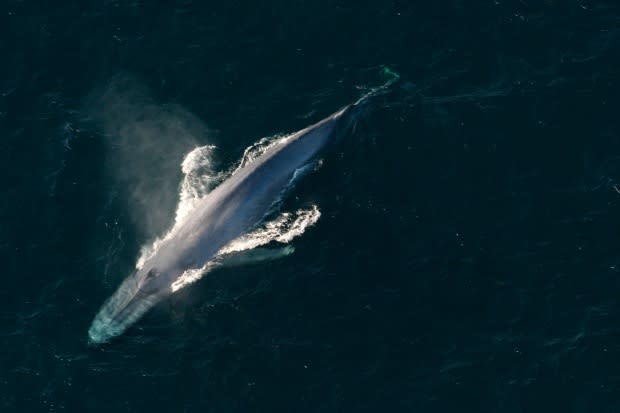Offshore oil exploration in N.L. often occurs without wildlife monitoring
Oil and gas exploration using powerful air guns shown to be harmful to marine life regularly occurs off the coast of Newfoundland and Labrador without environmental monitoring, according to documents obtained by CBC News.
Federal regulations require the presence of wildlife observers whenever companies hunt for new fields in the province's multi-billion dollar offshore industry.
But when factors as frequent as fog, high seas or darkness make visual wildlife observation impossible, seismic ships are under no obligation to stop work.
"These operations very clearly have the potential to cause a lot of harm to a lot of marine wildlife, " said Sean Brillant, a senior conservation biologist with the Canadian Wildlife Federation.
"If they are doing exploration in the dark or at times when observers are incapable of making adequate surveillance of an area then they are almost definitely causing harm [to wildlife]."
In theory, regulations set by Fisheries and Oceans Canada require observers to ensure the area around any seismic ship is clear of all mammals and turtles before seismic tests can begin. Once a seismic survey has begun, operations will only be shut down if a threatened or endangered species is spotted.
5,200 animals spotted, 0 work stoppages
Seismic surveys use powerful sound waves capable of penetrating the ocean floor to map oil and gas reserves.
Documents obtained from the Canada-Newfoundland and Labrador Offshore Petroleum Board (C-NLOPB) indicate that in 2017 and 2018, surveys already underway were never suspended due to environmental concerns.
Those same reports show that, on occasions when observation was possible, more than 5,200 marine mammals were observed while seismic air guns were firing. Those animals were not reported as threatened or endangered species, so testing was not stopped.
Seismic surveys were temporarily postponed before beginning on 14 occasions, when marine life was spotted near vessels before air guns started firing.
Differences between provinces
In Nova Scotia, during low-visibility conditions all seismic vessels must use a second form of environmental monitoring, called passive acoustic monitoring (PAM), to detect the presence of marine mammals.
Those measures are not required in Newfoundland and Labrador.
In 2017, no seismic companies in Newfoundland and Labrador used acoustic monitoring during work in oil exploration. In 2018, PAM was only used by one company, PGS, and on a voluntary basis.
At the very minimum, there should be a marine mammal observers and passive acoustic monitoring at all times. - Lindy Weilgart
Nova Scotia's oil and gas regulator, the C-NSOPB, says due to the presence of at-risk species of whales in the province's waters "all vessels conducting seismic surveys in Nova Scotia waters during low visibility conditions are required to conduct PAM during operations."
The C-NLOPB declined an interview request from Radio-Canada. But in its own statement, it said "DFO has not identified any critical habitat" for at-risk marine mammals off the coast of Newfoundland and Labrador that would require acoustic monitoring.
'We're bowing down to industry'
Stéphanie Pieddesaux, a researcher with Merinov, a Quebec-based fisheries and aquaculture research centre explained that: "Often, mitigation measures will be more lax because it isn't a critical habitat."
"But that doesn't keep an animal from entering that area," she added.
Lindy Weilgart, an adjunct professor at Dalhousie University, said "at the very minimum, there should be a marine mammal observers and passive acoustic monitoring at all times."
"We're bowing down to industry," she said.

Weilgart, who has studied the impact of sound pollution on marine environments for more than two decades, said seismic surveys are increasingly being seen to have "an ecosystem-wide impact."
"To my count, there's about 130 marine species that have had documented impacts from seismic air guns," Weilgart said. "That much is clear."
Pieddesaux said the most powerful air guns used for seismic surveys can harm mammals' body tissue and lead to animals becoming disoriented. She said the use of air guns can also have an impact on whales feeding and migratory patterns, even if seismic activity "won't necessarily lead to to an animal being injured."
Visual observation aboard seismic vessels is also limited by the fact marine mammals "spend most of their time below the surface of the water," she said.
Acoustic monitoring can't detect sea turtles and can only monitor whales that make vocalisations.
For visual and acoustic monitoring to be effective, Pieddesaux adds, observers must be well qualified and experienced. A Radio-Canada investigation revealed last month that unqualified workers are regularly conducting environmental monitoring aboard seismic ships.
Other options?
Weilgart said that if Newfoundland and Labrador's offshore industry wants to reduce its environmental footprint, it needs to not only improve wildlife monitoring, but also start using exploration methods that are less harmful to the environment and that create less noise pollution.
"There are alternatives," she said.
"But since the petroleum boards and the regulators, the Department Fisheries and Oceans, are not insisting on them, they will not happen."
Read more articles from CBC Newfoundland and Labrador

